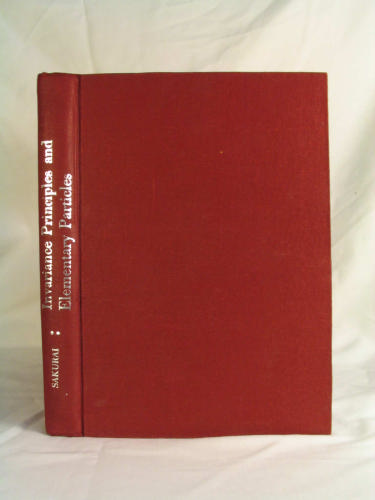Invariance Principles and Elementary Particles epub
Par atkinson laura le mardi, juillet 5 2016, 17:26 - Lien permanent
Invariance Principles and Elementary Particles by Sakurai J.J.


Download eBook
Invariance Principles and Elementary Particles Sakurai J.J. ebook
Page: 338
Format: djvu
ISBN: 0691079870, 9780691079875
Publisher: PUP
In general the elementary particles known as fermions and their antiparticles (constituents of matter) have spin=1/2 and the elementary particles known as bosons (the particles that facilitate interaction among fermions) have spin=1. I was reading Sakurai's "Invariance Principles and Elementary particles". These relationships could be found by "pure thought" of sufficiently intelligent observers, at least in principle. Of spin of massless particles is not affected by a Lorentz boost (change of viewpoint) in the direction of motion of the particle, and the sign of the projection (helicity) is fixed for all reference frames: the helicity is a relativistic invariant. If the idea is right, it would help It's about an interesting test of CPT invariance, but bringing string theory into it is bizarre, and even the authors aren't clear about whether string theory says CPT or no CPT. All the current theories, as Quantum Field Theory, Nuclear Physics, Particle Physics, Standard Model, etc., all they keep the fundamental principles of Quantum Mechanics. The BB84 protocol was based on one party's sending polarized particles to the other and relied on the Heisenberg uncertainty principle for security, since any eavesdropping will alter the results and thus be detectable. This potential catastrophe is prevented by gauge invariance, and the only possible gauge invariance for spin-2 fields is general covariance (diffeomorphism symmetry) of GR. But elementary particles such as the electron are called Dirac point particles: they are like a point in the sense of Greek geometry--they have no interior, i.e., no width, no breadth, no length, no insides. Symmetry has been a powerful concept in physics for nearly 100 years, allowing scientists to find unifying principles and build theories that describe how elementary particles and forces interact now and in the early universe. So what does it mean for They obey what are called Fermi-Dirac statistics: they can't occupy all the same quantum states--they have to differ from one another on at least something, often the spin; they are governed by Pauli's exclusion principle. Since this conflicts with the rules governing mass and velocity, as I understand, I suggest that poor Mary's atoms begin to heat up and vibrate to the point that they disintegrate into more fundamental particles. Since the early days of quantum mechanics, and even the old quantum theory, people knew that particles and waves were just two aspects of the same thing. A theory of fundamental particle interactions built from the gauge invariance principle alone doesn't allow the existence of massive gauge bosons. The first, based on the equivalence principle of general relativity, leads to the No Drama scenario: Because Alice is in free fall as she crosses the horizon, and there is no difference between free fall and inertial motion, she shouldn't feel extreme effects of .. The findings could have implications for superstring theory — the idea that all fundamental particles are actually loops of vibrating string — which is one attempt to unify nature's forces and create a theory of everything. With the rapid development of the physics of elementary particles during the 1950s, new conservation laws were discovered that have meaning only on this subatomic level. As mentioned in the description of the 1995 Milestone, the 2001 Nobel Prize in physics was awarded not only for the achievement of Bose-Einstein condensation but also “for early fundamental studies of the properties of the condensates”.